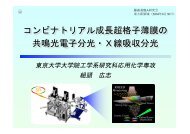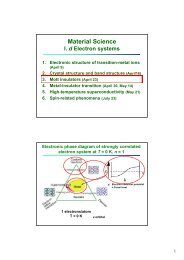Thesis High-Resolution Photoemission Study of Kondo Insulators ...
Thesis High-Resolution Photoemission Study of Kondo Insulators ...
Thesis High-Resolution Photoemission Study of Kondo Insulators ...
Create successful ePaper yourself
Turn your PDF publications into a flip-book with our unique Google optimized e-Paper software.
8.3. Results and Discussion 119<br />
depressed DOS (arb. units)<br />
0<br />
FeSi 1-xAl x<br />
DOS(295 K) - DOS(7 K)<br />
0.05<br />
0.10<br />
0.15<br />
x<br />
- 0 meV<br />
- 20 meV<br />
- 50 meV<br />
- 100 meV<br />
- 200 meV<br />
0.20<br />
0.25<br />
0.30<br />
Figure 8.7: Substitution-dependent depression <strong>of</strong> the spectral DOS from 295 K to 7 K<br />
at various energies. The DOS values are from Fig. 8.6, where the spectra have been<br />
normalized below − 0.4 eV.<br />
small substitution as presented in Fig. 8.4 (a), is sensitive also to a small temperature<br />
increase. No temperature dependence appears in the x = 0.30 spectra as shown in the<br />
bottom panel <strong>of</strong> Fig. 8.8 (a). On the other hand, a strong substitution dependence<br />
remains down to ∼−250 meV or further below. As already mentioned for Fig. 8.4,<br />
the substitution dependence becomes strong with increasing temperature. Such strong<br />
substitution dependence at high temperatures is not present in the spectral DOS <strong>of</strong><br />
Yb1−xLuxB12.<br />
Note that in Fig. 8.8 the difference DOS at 150 K, 225 K, and 295 K grows in<br />
proportion to the deviation <strong>of</strong> Al content from x = 0.30. Such a smooth evolution <strong>of</strong><br />
the DOS with substitution would also be present at lower temperatures but would be<br />
compensated with the pseudogap opening. In particular, the bottom panel <strong>of</strong> Fig. 8.8<br />
(b) shows an apparent temperature independence <strong>of</strong> the spectral DOS below ∼−50<br />
meV.<br />
Tonogai et al. have measured the optical reflectivity <strong>of</strong> the same samples and deduced<br />
the optical conductivity [8.14] as shown in Fig. 8.9. The overall temperature






